I thought that this month I would return to looking in depth at just one particular soldier who had lost his life one hundred years ago. I chose as my subject a young man by the name of William Darch who died in France in July 1917.
It always surprises me, when doing any World War 1 research, how many casualties shared the same name. I’m not any expert in probability but the recurrence of so many makes me aware of just how high the total death toll must have been.
I could see, when looking for articles in the British Newspaper Archive, that there were many William Darches living in North Devon at the same time. However, when using the linked records aspect of the Ancestry website, I realised that “my” William Darch had been linked to the Census details of another, both living in Pilton, a short walk from eachother. I then thought that perhaps I could use this as a cautionary exercise in taking care, wherever possible, to cross reference family history research.
This blog follows just a few of the William Darches who were living in North Devon and who also served in the First World War. I have tried to identify each man in the 1911 Census to help to clarify that these were separate individuals.
The William Darch who died in France on July 31st was the eldest son of William and Polly Darch. In 1911 the family are living at 10 Priory Gardens, a line of cottages with deep front gardens, above and to the east of the church. Both Williams, father and son, are described as glove cutters and the obituary notice confirms that the younger, and probably the elder too, worked at the glove factory on the other side of the churchyard between Ladywell and Dark Lane. William Senior had been born in Swansea, perhaps this was why his son joined the Royal Welsh Fusiliers.
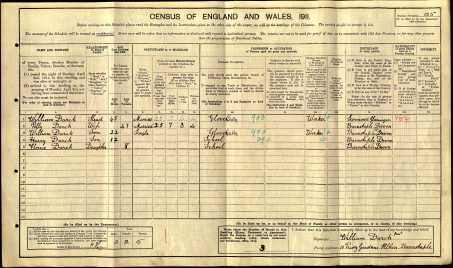
The Census notes that the couple had been married for 25 years and had had seven children, four of whom had died. The younger William was then aged 22 with a ten year gap between him and the next sibling Harry. No other children appear in either the 1901 or 1891 Census records and none of the family were baptised at Pilton Church. However the burial register records four Darch children of two years or less in age between 1888 and 1908 which, as there was no cremation in those days, almost certainly includes William’s siblings.
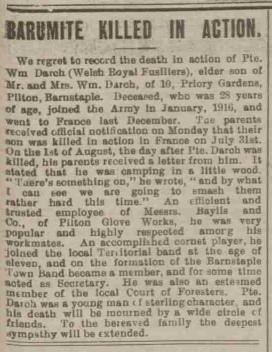 The North Devon Journal reports that, on the day after William’s death, his parents had received a letter from him saying that he was camping in a little wood and that there was “something on”.
The North Devon Journal reports that, on the day after William’s death, his parents had received a letter from him saying that he was camping in a little wood and that there was “something on”.
William Darch’s grave lies on the other side of the French border in the New Irish Farm Cemetery, West Vlaanderen, Belgium, just to the north of Ypres. Many soldiers were re-interred here from other cemeteries and so this final resting place does not necessarily indicate where he fell.
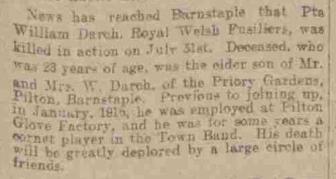
It would seem that William was a single man and had joined up eighteen months beforehand at a time when conscription had been introduced. The local papers include many reports from the Appeal Tribunals where individuals could put forward their personal circumstances and employers could argue the case for retaining their workers. Later that year another William Darch, a twist hand at the Derby Lace Factory had been passed for service at home, labour unit only etc and given conditional exemption. The 1911 Census, as seen below, records William Darch, lace twister, then aged 36 years with two young children, living in Princess Street.
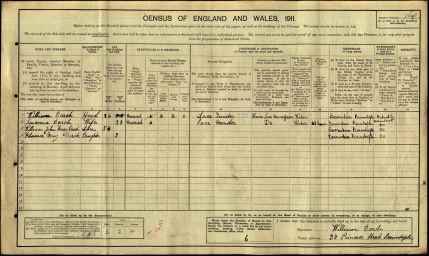
Halfway down Pilton Street, sandwiched between larger Georgian properties, is a small cottage, formerly the home of another William Darch and his wife Ethel. This William died in hospital in Basra suffering from malarial disease, coupled with yellow jaundice in December 1916. William and Ethel, née Gratton, had been married at Pilton Church on 30th May 1914.
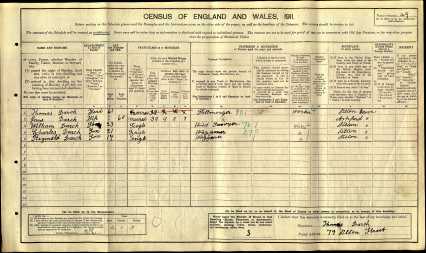
Here we see him in 1911 with his parents living at the top of Pilton Street.
His obituary, in the North Devon Journal, states that he had been treated three times for the same disease and had been expected to recover from this last bout.
At home he had worked as a sawyer and liner at the Newport Cabinet Works, having been previously employed in the same trade at the Raleigh Works, later Shapland and Petter, by the Long Bridge.
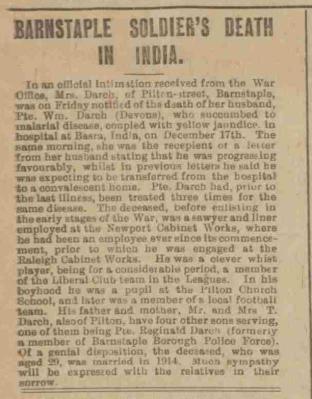
A clever whist player, his name can often be found in the weekly scores in the local paper in the years before the War.
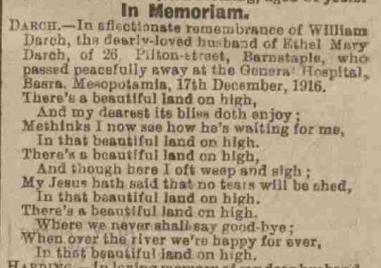
Note that the headline and text of his obituary, published in the North Devon Journal and reproduced here, refer to William’s death as being in India but that he actually died in Basra, then in Mesopotamia. The 6th Devons had served in India so perhaps this led to the confusion.
William had enlisted in the early stages of the war, and so he and Ethel had had only a few months of marriage beforehand.
I have not found any evidence of her re-marriage so can only assume that she lived out her days as a widow.
Our next William Darch was the son of Mr T Darch of Lovacott. He had been sent home from the Front suffering from frostbite, returning to active service in the June of 1915. In September 1916 the Journal reports that he had died in action on August 26th.


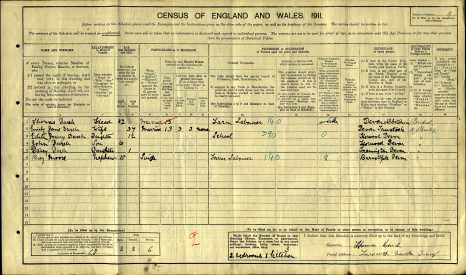
This William proved more elusive to trace in the 1911 Census. I found a Thomas Darch, who I assumed to be his father, shown above as living in Horwood in 1911 but was puzzled to see he had said that he had only been married 13 years. Tracing him back, using his place of birth of Abbotsham, I found that in 1891 he had been married to Clara E. and had an infant son Alfred. At first I could not find him in 1901 but found 10 year old Alfred, together with an 8 year old William Darch and their 5 year old sister Minnie (born at Horwood), listed as “wife’s grandson/daughter” at the Royal Mail public house, Bideford, run by Albert DARK and his wife Lavinia. Marriage records show a Thomas Darch marrying a Clara Ellen Marland in 1890 and a Lavinia Marland marrying an Albert John Dark in 1881 so all that fitted.
![]()
I found a death notice in the Journal stating that Clara had died on January 3rd 1898 aged only 23 years, perhaps as many women did, in childbirth. There is no child mentioned as buried with her in the Bideford burial register so one would have to buy her death certificate to confirm the cause of her demise. According to the General Register Office indexes Thomas Darch had married Emily Jane Moore relatively soon afterwards, at some time during the first quarter of 1898, and I then found this new family recorded at Horwood in 1901 with young children Frank, aged 4, and Edith aged 2. Emily’s mother and a young nephew are living with them, although not, as we have seen, his children by his first marriage. Frank’s age seems to pre-date his parents’ marriage so he appears to have been born illegitimately.

Whether Frank was Thomas Darch’s natural son or not, he is described as such in the above cutting which refers to his being home on leave in February 1916. The account of William’s death refers to another son of Thomas Darch having died previously in the conflict but I have not been able to confirm whether this was Frank or Alfred.
Our last William Darch, actually William Henry Darch of Combe Martin can be found in the 1911 Census, living at home with his parents at Chapel Cottage (this detail is given on the other side of the page), Castle Street. The Census tells us that he was the only child of William and Lucy Darch and that he was then aged 23 and working as a carpenter.
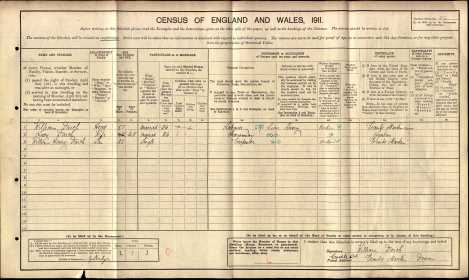
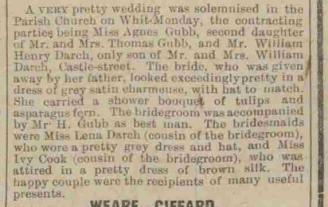 William was married in the village church on Whit Monday 1915 to Agnes Gubb, a local girl. As was usual at the time, the Journal article is very descriptive of the wedding attire – white dresses were not standard wear and so each event warranted a detailed account.
William was married in the village church on Whit Monday 1915 to Agnes Gubb, a local girl. As was usual at the time, the Journal article is very descriptive of the wedding attire – white dresses were not standard wear and so each event warranted a detailed account.
As said above, there were many people of the same name, even with the Henry added in, and I could not easily find from the newspapers whether he had served, and died or survived, or been granted exemption. As there are no Censuses available later than 1911 I thought I would check the 1939 Register to see whether he was alive at the beginning of World War Two.
I found Agnes, listed as a widow, living at The Weir, Combe Martin with her daughter Marjorie who had been born in June 1917. This register was updated until relatively recent times with the new surnames of any women who subsequently married. We can see then not only Marjorie’s married name but also that Agnes herself must have remarried after 1939.

Looking back through for a death notice in the local papers I found these items from 1933.
So William had served, but been injured and had afterwards lived on the other side of the country, away from his wife and young daughter.
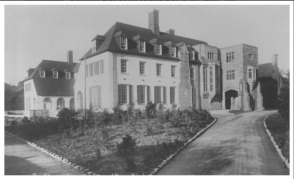
The first Star and Garter Home had been opened in 1916 in a former public house in Richmond, from which it took its name, to care for the severely disabled young men returning from the Front – the average age of the occupants being, at that time, 22. The home at Sandgate, near Folkestone, was purchased in 1919.
I then checked the “burnt” WW1 service records to see if William’s had survived the fire at the War Office during the Blitz and found that, luckily, his had done so. From this we can see that he had enlisted in November 1915, only months after his marriage. The record is not easy to read but he seems to have been discharged on 16th January 1917, only months before his daughter’s birth. A Ministry of Pensions form dated 1st Feb 1919 gives neurasthenia as the cause of his discharge and notes the assessment of his disability at 30% to be reviewed in six months time. Para 392 (xvi) KR (Kings Regulations) No longer physically for war service and the additional note Character fair.
Neurasthenia, an outdated term nowadays, was also known as shell shock and perhaps today would be classed as ME or post traumatic stress disorder. It was given as the cause of many WW1 discharges, including that of my own great grandfather who, although he returned to civilian life, seemed to have had personality issues and a disablement to overcome.
The Journal report of William’s funeral in June 1933 comments that the sympathy of parishioners was evidenced by the large number who attended, and the extensive list of floral tributes looks to have included most, if not all, of the village. The funeral was carried out with military honours and the procession was led by the town band, many bandsmen also being members of the British Legion. Almost 15 years after the end of the Great War it serves as a salutary reminder that not all of its casualties died between the years of 1914 and 1918.
As said, there were many William Darches living in North Devon at the time of the First World War, and of these there were others who also served and possibly lost their lives.
Although this month’s blog has not, after all, turned out the way I expected, I hope that it has illuminated the difficulties of confirming the identities of like-named ancestors and underlined the importance of cross-checking with as many sources as possible.
The more of these stories I research the more I come to appreciate and understand the long term effects of the First World War which, when I was growing up, had been overshadowed to an extent by those of the more recent Second.
DG
Pilton parish registers – transcripts – Local Studies Centre, Barnstaple
North Devon Journal; Exeter and Plymouth Gazette: – British Newspaper Archive (online – available free in the Local Studies Centre, charge for printouts)
1911 Census; British Army WW1 service records: – Ancestry Library Edition – (free access available in the Local Studies Centre and any Devon library, subject to conditions)
1901 Census; 1939 Register; Bideford burial register: – findmypast (online – available free in the Local Studies Centre, charge for printouts)
Photograph of Star and Garter Home, Folkestone – http://www.folkestonehistory.org
History of the Star and Garter Homes – https://starandgarter.org/about-us/history

